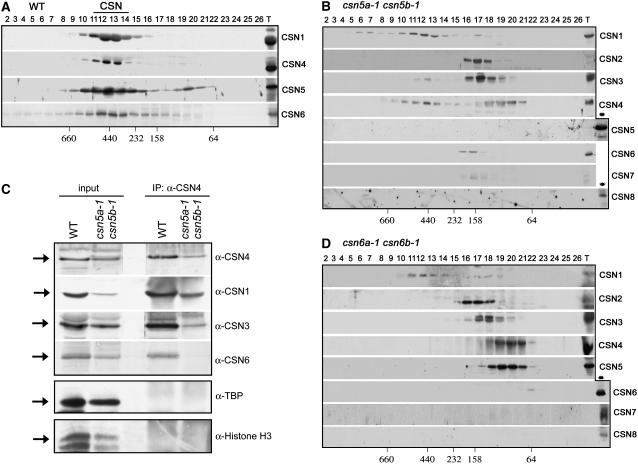Figure 6.
Both MPN Subunits CSN5 and CSN6 Are Essential for Maintaining the Structural Integrity of the CSN Complex.
(A), (B), and (D) Immunoblot analyses of Superose 6 gel filtration chromatography fractions obtained from 13-d-old light-grown wild-type (A), CSN5 complete loss-of-function mutant (csn5a-1 csn5b-1) (B), or CSN6 complete loss-of-function mutant (csn6a-1 csn6b-1) (D) seedlings. Column fractions were subjected to SDS-PAGE and immunoblot analyses with anti (α)-CSN1, α-CSN4, α-CSN5, and α-CSN6 (A) or α-CSN1, α-CSN2, α-CSN3, α-CSN4, α-CSN5, α-CSN6, α-CSN7, and α-CSN8 ([B] and [D]) polyclonal antibodies. Fraction numbers are indicated. Lane T contains the total unfractionated extracts. The asterisks indicate total unfractionated wild-type extract. Loss of function of CSN5 (B) or CSN6 (D) in csn5a-1 csn5b-1 or csn6a-1 csn6b-1 double null backgrounds results in the disassembly of CSN subunits into CSN-independent subcomplex forms.
(C) CSN4 associates with CSN1 and CSN3 in csn5a-1 csn5b-1 double null mutant seedlings. Total soluble protein extracts (input) from 13-d-old wild-type and csn5a-1 csn5b-1 double mutant seedlings were incubated with CSN4 antibody coupled to protein A-agarose (see Methods). The immunoprecipitates (IP) were then separated by SDS-PAGE and immunoblotted with antibodies against CSN1, CSN3, CSN4, CSN6, TBP, and histone H3, as indicated.

